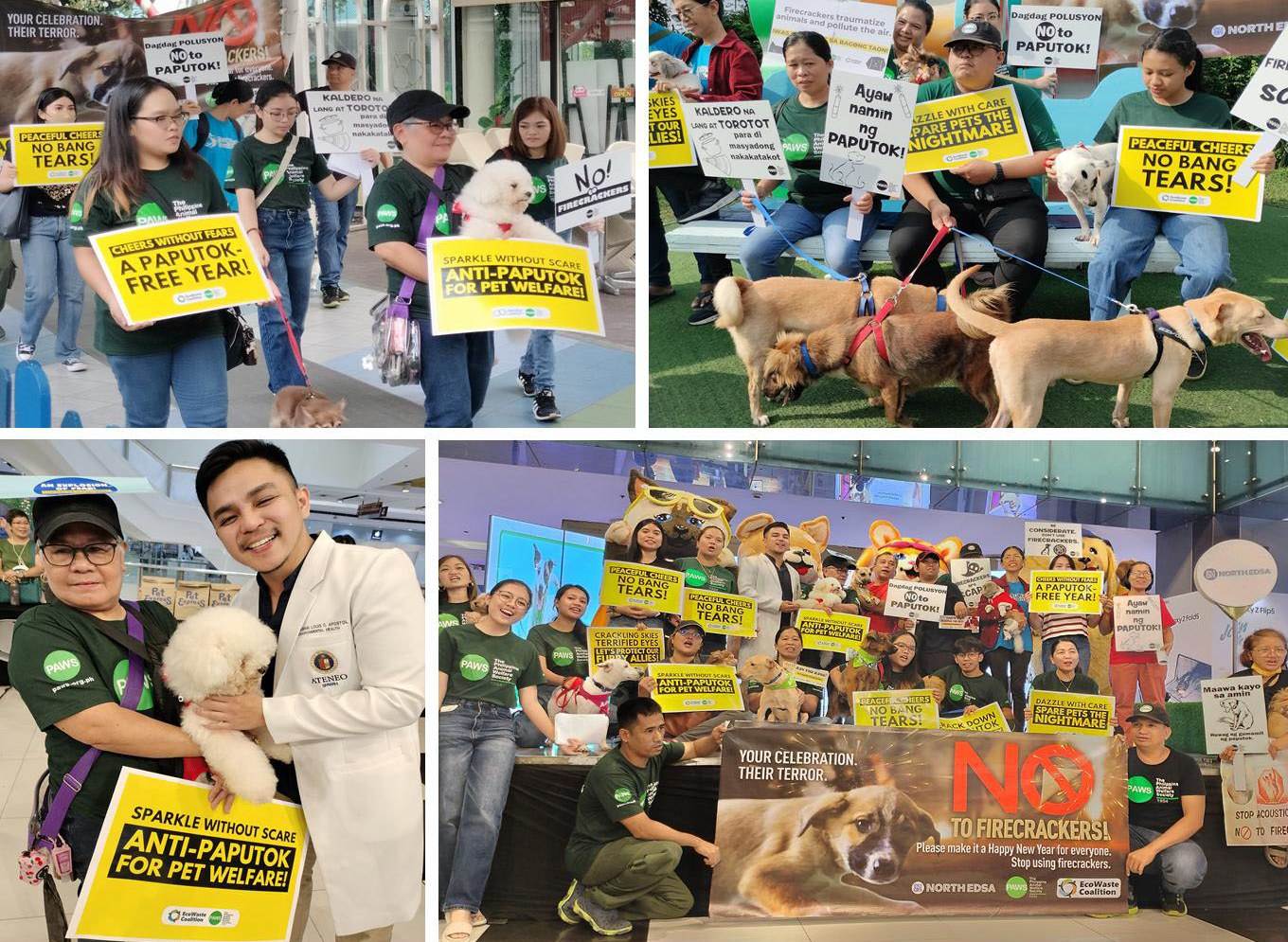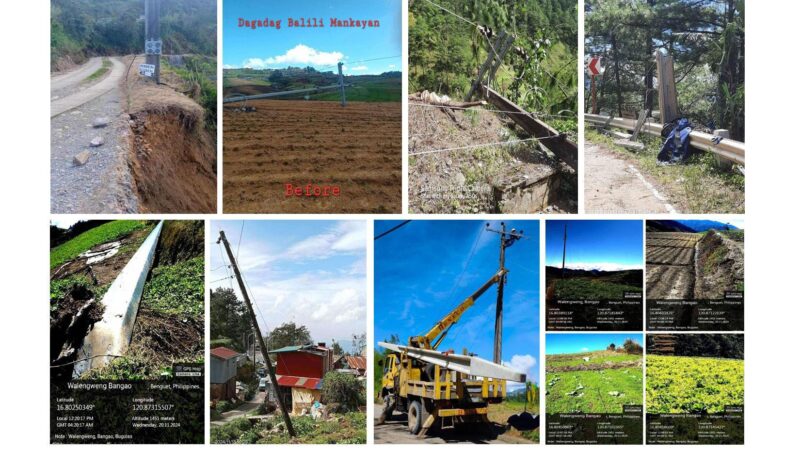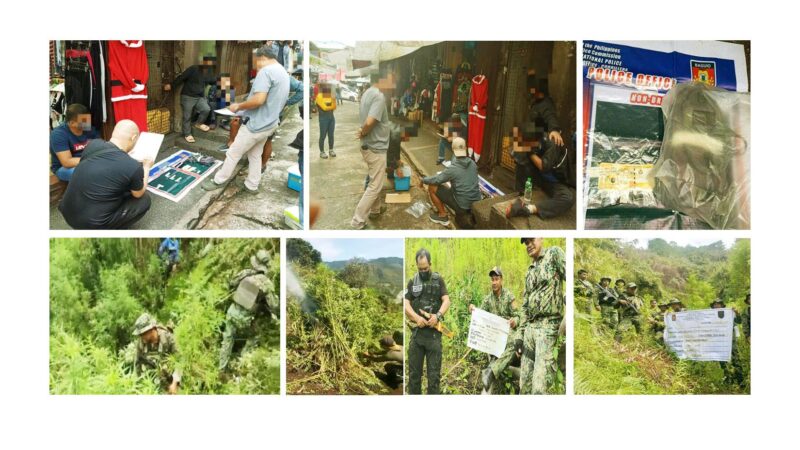Groups: Firecrackers Can Traumatize Animals and Pollute the Air

NO TO FIRECRACKERS. The Philippine Animal Welfare Society (PAWS) and the EcoWaste Coalition urged the general public to refrain from lighting firecrackers and other pyrotechnic devices to protect animals such as cats and dogs from loud bangs and flashes of lights, which can cause immense anxiety, fear, and stress for our furry companions. Contributed Photo for Filipino News Sentinel
QUEZON CITY – (28 December 2023) An animal welfare group and an environmental health group today urged the general public to welcome the New Year sans firecrackers and fireworks to protect animals such as cats and dogs, as well as the ecosystems, from harm.
In an “Iwas Paputoxic” event held at the premises of SM North in Quezon City, the Philippine Animal Welfare Society (PAWS) and the EcoWaste Coalition put the spotlight on the adverse effects of lighting firecrackers and other pyrotechnic devices on human feline and canine friends, and to humans themselves, including the environment we live in.
Fur parents together with their pets paraded through the mall with placards carrying messages exhorting the public to celebrate responsibly without the loud bangs and flashes of light from exploding firecrackers and fireworks, which can be very frightening and stressful for cats and dogs.
“The exploding noise from firecrackers and other pyrotechnics is torture to animals like cats and dogs who have a very keen sense of hearing. It brings about a terrified response from many dogs and they could sustain serious and even fatal injuries just trying to get away from the deafening noise. There is usually an increase in reports of lost pets during the first week of January due precisely to pets escaping from the confines of their homes during New Year’s Eve after being spooked by firecrackers,” said Anna Cabrera, Executive Director, PAWS. “The situation is even worse for strays who often find themselves with no safe space to hide in.”
“Aside from the ear-splitting noise, smoke inhaled from detonated firecrackers may cause anxiety, disorientation, loss of appetite, and an upset stomach for our furry companions. What is worse is if they accidentally eat remnants of the firecrackers as this will result in gastrointestinal problems – symptoms of which could be abdominal pain, blood diarrhea, and vomiting,” she added.
The “Iwas Paputoxic” event also raised concern over the toxic pollution brought about by exploding firecrackers and fireworks, especially on New Year’s Eve.
“The air quality can reach hazardous levels due to the massive use of firecrackers and fireworks before and during the revelry. This can put the health of children, senior citizens, and those with pre-existing medical conditions at grave risk as exposure to particulate matter and other toxic environmental pollutants can trigger or worsen respiratory ailments like asthma, bronchitis, laryngitis, pneumonia, rhinitis, and sinusitis,” said Dr. Geminn Louis Apostol, environmental health specialist, Ateneo School of Medicine and Public Health. Among these pollutants are greenhouse gases, particularly carbon dioxide, carbon monoxide, and nitrogen oxide, which contribute to global warming and climate change.
“Cats and dogs, humans, and the ecosystems would be better off without injurious and polluting firecrackers and fireworks,” said Aileen Lucero, National Coordinator, EcoWaste Coalition. “We therefore encourage everyone to think twice before spending hard-earned money for toxic firecrackers and fireworks, which are better used for essential needs like food on the table. Pera para sa paputok ay sa pagkain na lang itutok.”
PAWS and the EcoWaste Coalition provided fur-parents with these practical tips to make the New Year celebrations safe for their pet cats and dogs:
1. Walk or take your pets for a run or physical activity before it gets dark so they will be tired by night time and will be soundly sleeping by the time the revelry begins.
2. Keep pets inside to avoid them becoming stressed or exposed to loud explosions and toxic fumes. Never chain or tie them outside your home – not only during New Year’s Eve; chaining or tethering should never go beyond an hour – as companion animals are meant to share family activities with us inside our home.
3. Escape-proof your home to prevent pets from going out during the revelry. Make sure they have a collar with a tag indicating the pet owner’s details.
4. Make pets pee or poo before the revelry starts, and give them ready access to water.
5. Provide a quiet and safe spot where pets can stay during the revelry; shut the windows, pull the curtains down, and play soft music inside your home.
6. Turn on the television if this will help mask the noise of the firecrackers outside and if you think your pet prefers the sound of the TV over other loud noises.
7. Act as normal and as calm as possible even while the explosions are at their worst so that your pets will take a cue from your behavior – that there is nothing to be alarmed about. Fussing over your pet may have the effect of increasing their tendency to panic.
8. Talk to your veterinarian about giving your pet drops of “Rescue Remedy” or calming edible drops on their favorite treat (available in organic pet supply stores) ahead of time. Buy or make an anxiety vest for dogs that have an extreme fear or trauma response to firecrackers.
9. Keep alcoholic drinks, chocolate, fruit cake, nuts, shopping bags, tobacco products, and cleaning agents out of the pet’s reach to prevent choking and poisoning incidents.
10. Give stray animals a safe haven in your garage if you have the space – provide temporary shelter, food, and water, especially during the revelry. ### (PR)







